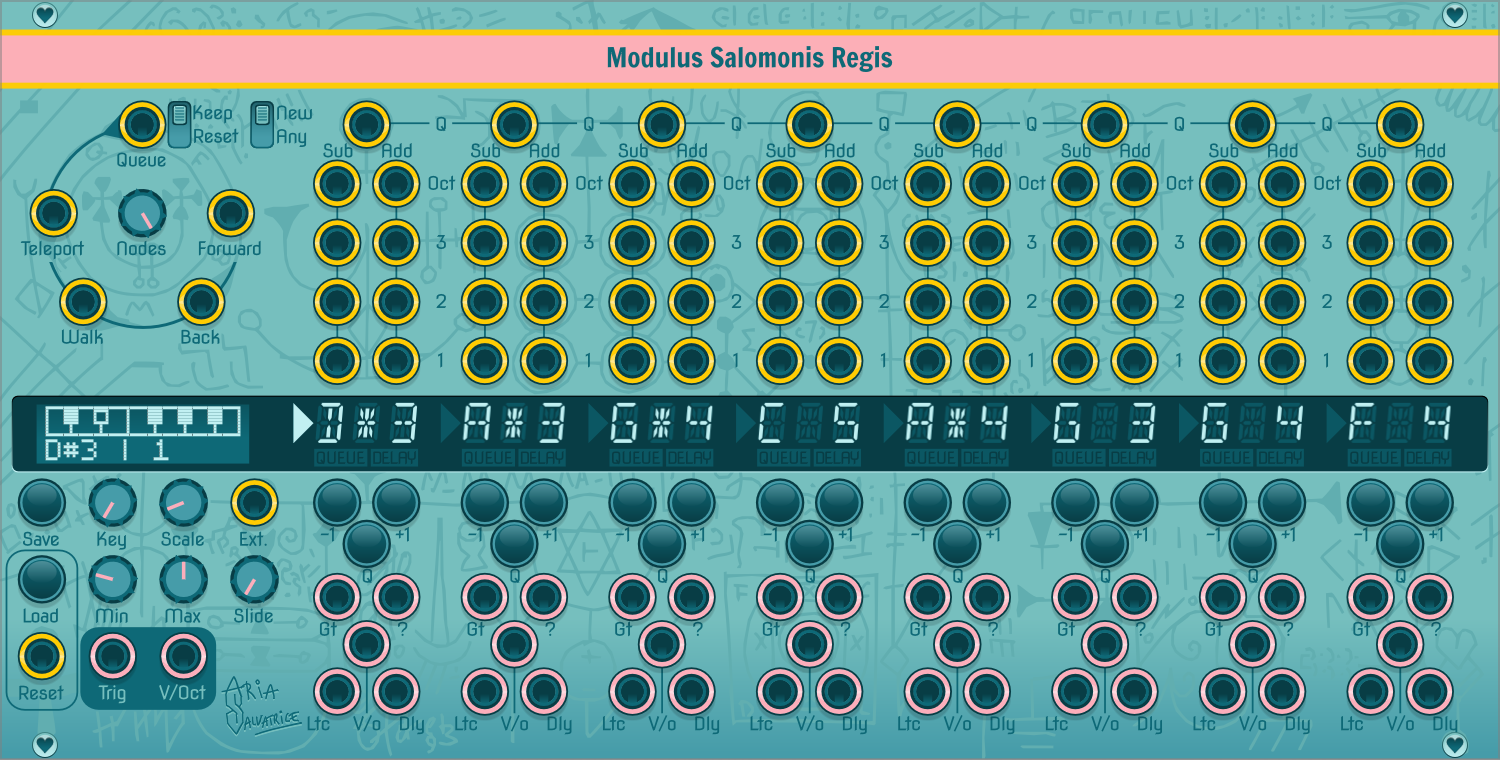
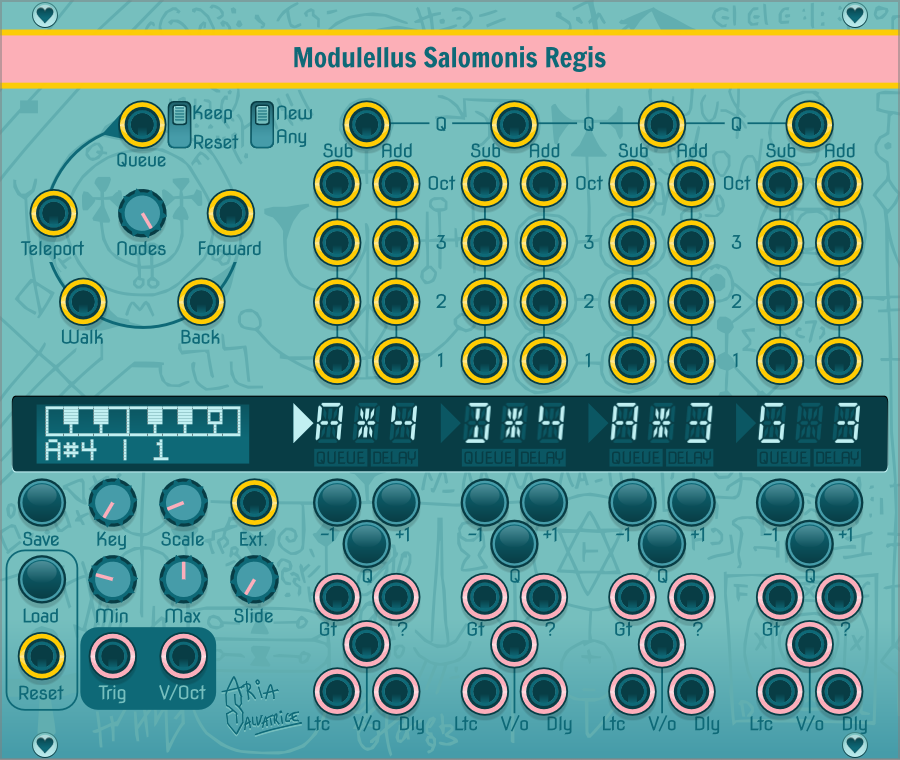
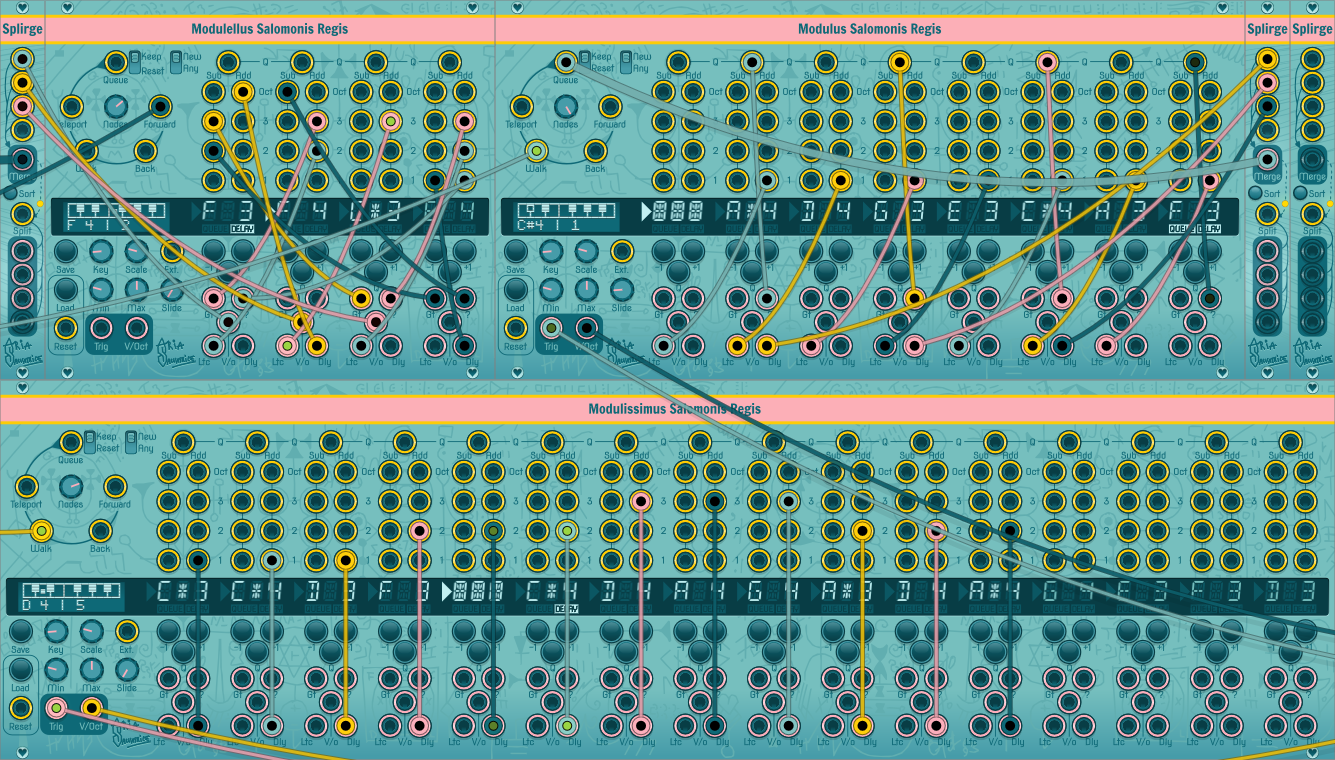
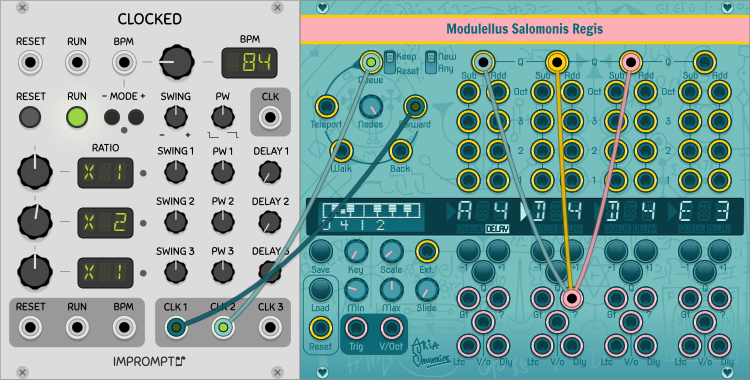



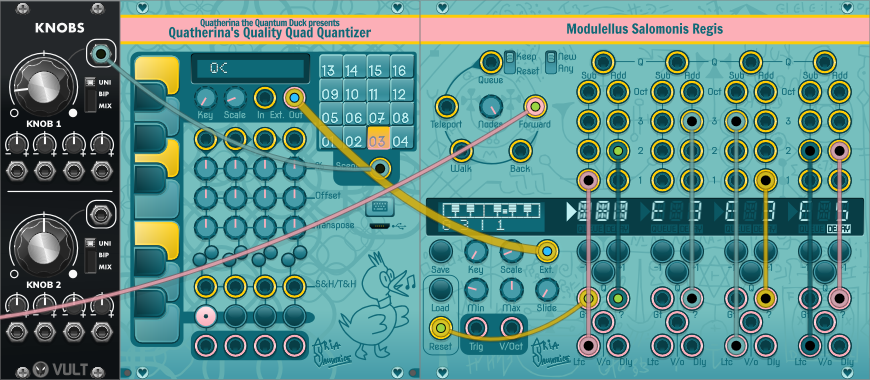
Modulus Salomonis Regis
Conjuring Knowledge of the Arts
Modulus Salomonis Regis is a faithful reproduction of a vintage hardware module created in 949 BC by Solomon, son of David, King of Israel.

Amduscias a great and a strong duke, he commeth foorth as an unicorne, when he standeth before his maister in humane shape, being commanded, he easilie bringeth to passe, that trumpets and all musicall instruments may be heard and not seene, and also that trees shall bend and incline, according to the conjurors will, he is excellent among familiars, and hath nine and twentie legions.
—Pseudomonarchia Daemonum, De praestigiis daemonum, Johann Weyer
Knowledge is granted to those who master sigils. By self-patching outputs back to inputs, you draw seals on the surface of the module. Should your sigil be well-conceived, you will gain grand knowledge.
Form Factors
The module is available in three different form factors. All three are identical, but offer a different amount of maximum nodes.
- Modulellus Salomonis Regis: 4 maximum nodes, 30hp. This is good for chords.
- Modulus Salomonis Regis: 8 maximum nodes, 50hp. This is the recommended variant.
- Modulissimus Salomonis Regis: 16 maximum nodes, 89hp. You should not consider this one if this is your first ritual.
While I recommend you get started on Modulus Salomonis Regis, the 8 nodes version, in this documentation, we will use a picture of Modulellus Salomonis Regis, the 4 nodes version, to fit on the screen easier.
Whenever Modulus Salomonis Regis is mentioned on this page, it is interchangeable with the two other variants.
Getting started
Understanding Modulus Salomonis Regis is easier if we create a little patch first, before explaining the controls in detail. You can follow along on any version of the module you want.

First, patch a clock to the Forward input. A LFO's square wave can also be used, if you don't have a clock.
Then, right-click the device and pick "Randomize all nodes" near the bottom.
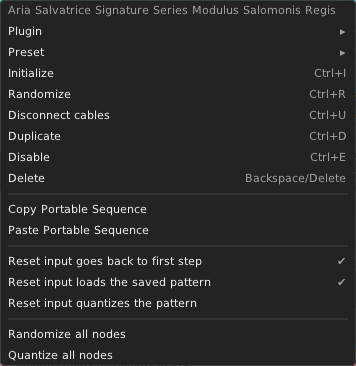

Patch the CV out to the V/Oct input of an oscillator, and listen what happens.

Patch the Gate output of the first node to the any of the inputs labeled 1, directly above the segment display.
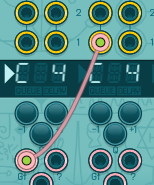
Listen what happens: every time the second node is reached, the note of the connected node changes by +1 or -1 scale degree. By default, the scale used is C Minor.
Self-patching is the primary way of programming Modulus Salomonis Regis.
Now, connect more outputs to inputs randomly, and listen to the results.
Modulus Salomonis Regis is much easier to understand through experimentation than explanation. If any part of the manual is hard to understand, skip it for now.
Step Inputs
To move through the nodes, at least one of the five Step Inputs must receive triggers or gates.

Queue: Move to one of the enqueued nodes, selected at random from the queue if there is more than one. If no nodes are enqueued, then this input does nothing.

Nodes can be added to the queue from their corresponding Q (Queue) jack, or by pressing their Q (Queue) button. When in the queue, the word Queue is lit on the segment display.

When the rocker switch next to the Queue input is set to Keep, other enqueued steps will not be removed from the queue after one is picked at random. If it's set to Reset, then the queue will be emptied of the other options.

Teleport: Move to a random node.

If the rocker switch is set to New, it will never teleport back to the current step (unless only a single step is enabled). If it is set to Any, then the current step will be considered a valid destination.

Walk: Move one node to the left or right randomly. When at either edge, wraps around.

If the rocker switch is set to New, it will perform a random walk, 50/50. If it is set to Any, then there is 1 chance out of 3 of staying on the current step instead of walking.

Back: Move one node to the left. When at the beginning, wraps around.

Forward: Move one node to the right. When at the end, wraps around.
When multiple step inputs receive a gate or trigger at the exact same time, inputs are processed in the following order of priority: Queue > Teleport > Walk > Back > Forward. The arrow displayed on the summoning circle will remind you of this.
You can exploit these priorities by sending different clock divisions to different inputs, or to patch a fallback option for the Queue input.

You can use the Nodes knob to use fewer nodes than the maximum. Unused nodes will be dimmer on the segment display. They can still be programmed, but they cannot be reached by Step Inputs.
Step Windows
As soon as a Step Input is accepted, a Step Window of 1 millisecond opens. During that time, the CV inputs of every node become active. Outside of Step Windows, the nodes will not react to CV input.
Protip for cool kids only
Not only there is no good justification for trying to understand how Step Windows work, it's actually harmful to even attempt to.
Here's precisely how things happen:
- A valid Step Input is received. A Step Window opens for a millisecond.
- The CV inputs of nodes listen for incoming triggers or gates. They can't accept multiple triggers during the Step Window, either they receive something or nothing.
- The Step Window closes: every node processes every input it received. Sub and Add inputs can cancel out each other.
- The Step is applied: a Global Trig is sent, the Global CV is updated (with Slide if any), the current node's Play indicator lights up, and the new current node sends out its gate outputs continuously, until the next Step Window closes. Thus, the gates the current node is sending will be picked up during the next Step Window.
- The module waits 2 milliseconds before allowing another Step Input to be received.
- Once another Step Input is received, another Step Window opens for a millisecond.
- The outputs from step 4 are still active: if they are patched, they are picked up during this Step Window.
- The Step Window closes, and the outputs from step 4 no longer send output.
In software, every single patchcable adds one sample of latency to its signal, by design.
The purpose of Step Windows is to make it easier to patch signals through external logic modules before patching them back into Modulus Salomonis Regis. So long as you pick logic modules that work at audio rates and do not add latency, you can patch a signal through more logic processors than you'd ever need and still make it in time to be picked up by the Step Window.
The lowest sampling rate generally used for audio is 44,100 samples per second: that means at least 44 samples per millisecond, the duration of a Step Window.
Modulus Salomonis Regis adds one millisecond of latency to incoming triggers, and can't move through more than 333 nodes per second. These limitations are negligible for most use cases.
LCD & Programmer
Below the Step Input are the LCD and Programmer.

The LCD shows you the note being played, the number of the current node, and gives you contextual information for a few seconds when you turn knobs.


The Save button saves the current node pattern in memory. There is only a single memory slot.
The Load button loads it.
As usual, I do not provide CV control over every button, but it's possible to automate them with CV-MAP or µMAP.
The Reset jack listens to input continuously, not just during Step Windows. When it receives a trig or gate, its behavior can be customized from the right-click menu:
- Reset input goes back to the first step (enabled by default)
- Reset input loads the saved pattern (enabled by default)
- Reset input quantizes the pattern (disabled by default)
Multiple behaviors can be enabled simultaneously.



The Key and Scale knobs allow you to select the scale from those provided by QQQQ.
You can also use the Poly External Scale input to send the scale, using the Poly External Scale format shared by my modules.

The Min and Max knobs allow you to restrict the range of pitches that can be selected before the node wraps around. Their naming is only a suggestion: it's safe for the Min to be higher than the Max.

Slide: The fun knob.

A Global Trig is sent whenever a Step Window closes. It's a short trigger, not a gate, no matter the duration of the input.

The Global V/Oct CV output sends the V/Oct value of the current node, with Slide applied if any.

Bileth is a great king and a terrible, riding on a pale horsse, before whome go trumpets, and all kind of melodious musicke. When he is called up by an exorcist, he appeareth rough and furious, to deceive him. Then let the exorcist or conjuror take heed to himself; and to allaje his courage, let him hold a hazell bat in his hand, wherewithall he must reach out toward the east and south, and make a triangle without besides the circle; but if he hold not out his hand unto him, and he bid him come in, and he still refuse the bond or chain of spirits; let the conjuror proceed to reading, and by and by he will submit himselfe, and come in, and doo whatsoever the exorcist commandeth him, and he shalbe safe.
—Pseudomonarchia Daemonum, De praestigiis daemonum, Johann Weyer
Nodes

Every node behaves identically, and can store four states:
- Pitch: Only twelve-tone equal temperament notes, no arbitrary CV. The asterisk stands for "Sharp". After changing the scale, pitches are not automatically quantized.
- Play: One and only one node is playing at all times. In addition to the play arrow, the node being played flashes for a split second when reached: it helps identifying repeating nodes, and helps you follow the movement when the module is heavily self-patched.
- Queue: When added to the queue, a node can be picked by the Queue Step Input. The Queue marker will be cleared if the node is played via Queue Step Input, or if a Queue Step Input picks another node while in Reset mode. When reached from another Step Input than the Queue Step Input, the Queue marker is not lost.
- Delay: The last node to have played has this Delay marker. If a node repeats, it will have the Play and the Delay marker at the same time.

The Gate output sends 10V continuously when the node starts Playing, until the next Step Window closes. When not playing, it sends 0V.

The Coin Flip output (labeled "?") has a 50% chance of sending 10V continuously when a node starts Playing, until the next Step Window closes. When not playing, it sends 0V.
Want another probability than 50%? Use the Gate output with a Bernoulli Gate!

The Latch output alternates sending 0V continuously and 10V continuously every time this specific node starts Playing, until the next Step Window closes. When not playing, it sends 0V.

The Delay output sends 10V continuously when the node obtains the Delay marker (that is, one step after it has Played), until the next Step Window closes. When not playing, it sends 0V.
Remember, in many configurations, a node can play twice in a row, sending 10V on its Gate and Delay output simultaneously.

The V/Oct CV output sends the V/Oct value of the node at all times. It is not affected by the Slide knob. It's useful to craft chords with Modulellus Salomonis Regis, the 4-node version.
Protip for cool kids only
Do not limit yourself to drawing Goetic sigils on Modulus Salomonis Regis! There exists countless traditions cataloging the symbols to bring forth dangerous, malevolent entities into the material plane.
If you manage to summon a new and exciting apparition, divinity, wanderer, wraith, ayakashi, jinn, zlydzen, yaoguai, etc, be sure to share your patch on patchstorage.com!

Each node has three buttons, accepting input at all times. From left to right:
- Subtract 1 Scale Degree (labeled -1): Subtracts 1 scale degree from the node, wrapping over and quantizing if necessary.
- Queue: Toggles the Queue marker of the node.
- Add 1 Scale Degree (labeled +1): Adds 1 scale degree to the node, wrapping over and quantizing if necessary.

The Queue input adds the node to the queue when it receives a gate or trigger during the Step Window.

The Subtract Octave input subtracts an octave from the node, wrapping over and quantizing if necessary, when it receives a gate or trigger during the Step Window. The corresponding Add Octave input to its right adds an octave instead.

The Subtract 3 Scale Degrees input subtracts 3 scale degrees from the node, wrapping over and quantizing if necessary, when it receives a gate or trigger during the Step Window. The corresponding Add 3 Scale Degrees input to its right adds 3 scale degrees instead.

Subtract 2 Scale Degrees and Add 2 Scale Degrees: same as above, with 2 scale degrees.

Subtract 1 Scale Degree and Add 1 Scale Degree: same as above, with 1 scale degree.
Remember, every node input received during a Step Window will be processed.
If you send both Add 1 Scale Degree and Subtract 1 Scale Degree, they cancel out each other.
If you send both Add 3 Scale Degrees and Add 2 Scale Degrees, you will actually add 5 scale degrees.

Paimon is constrained by divine vertue to stand before the exorcist; where he putteth on the likenesse of a man: he sitteth on a beast called a dromedarie, which is a swift runner, and weareth a glorious crowne, and hath an effeminate countenance. There goeth before him an host of men with trumpets and well sounding cymbals, and all musicall instruments. At the first he appeereth with a great crie and roring, as in Circulo [Empto.] Salomonis, and in the art is declared. And if this Paimon speake sometime that the conjuror understand him not, let him not therefore be dismaied. But when he hath delivered him the first obligation to observe his desire, he must bid him also answer him distinctlie and plainelie to the questions he shall aske you, of all philosophie, wisedome, and science, and of all other secret things. And if you will knowe the disposition of the world, and what the earth is, or what holdeth it up in the water, or any other thing, or what is Abyssus, or where the wind is, or from whence it commeth, he will teach you aboundantlie.
—Pseudomonarchia Daemonum, De praestigiis daemonum, Johann Weyer
Right-click menu

In addition to the Reset options explained above, from the Right-click menu, you can:
- Copy Portable Sequence: copies to the clipboard the current node pattern as a Portable Sequence.
- Paste Portable Sequence: pastes from the clipboard a Portable Sequence
- Randomize all nodes: sets all nodes to random notes in range from the current scale.
- Quantize all nodes: quantizes them to the current scale.
Sigils
To get you started, here's a few beginner rituals you can try out.
Send triggers to the Queue Step Input twice as fast as the Forward Step Input, stay in Keep mode, and randomly enable the queue of multiple steps at the same time: the module will have double time bursts once in a while.
Module used: Clocked
Patch the Latch and the Gate output of the same node to inputs that partially cancel out each other. In this patch, the third node will alternate between gaining one and two scale degrees.
Just add cables all over the bloody thing at random.